Industry thought leaders discuss what they learned during their recent pivot to virtual launches.
Launching a product in the past year, during a global pandemic, required a nimbleness that often belies a pharma product launch, but several companies accepted the challenge and created new strategies that enabled them to pivot and launch successfully under the unprecedented circumstances.
According to a McKinsey report, between February and August 2020 launches were disrupted by delays or lost revenues, or both. The report, Ready for Launch: Reshaping Pharma Strategy in the Next Normal, states  that companies chose to delay launches in 45% of cases, regulatory delays affected another 40%, and other external factors such as supply chain problems accounted for the remaining 15% of delays. In the United States, for instance, the median interval between approval and first scripts had increased more than threefold by May 2020, from 17 to 58 days, although it had shrunk back to 21 days by September.
that companies chose to delay launches in 45% of cases, regulatory delays affected another 40%, and other external factors such as supply chain problems accounted for the remaining 15% of delays. In the United States, for instance, the median interval between approval and first scripts had increased more than threefold by May 2020, from 17 to 58 days, although it had shrunk back to 21 days by September.
The pandemic also had a marked impact on the financial performance of the launches McKinsey analyzed. In 50 out of the 86 disrupted launches studied, companies lowered their expectations by 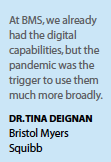 more than 25%. Overall, the changes in analyst consensus expectations between March and August 2020 represent a 9% decline in the net present value of the 86 drugs surveyed — the equivalent of a total loss of $10 billion globally.
more than 25%. Overall, the changes in analyst consensus expectations between March and August 2020 represent a 9% decline in the net present value of the 86 drugs surveyed — the equivalent of a total loss of $10 billion globally.
This was a daunting time to try to reach patients or physicians with information about a new product, but some companies met the challenge head on, with great success.
The Pivot Decision
One of those companies was Bristol Myers Squibb (BMS), which decided to delay the launch of its multiple sclerosis therapy Zeposia, which received FDA approval on March 25, 2020, a week after the country closed down due to COVID. BMS delayed the launch two months, using the time to get its employees prepared to work from home, to consider new digital strategies, and to get comfortable with the new normal.
“The decision to delay that launch was very much informed by not only connecting with our own people but also our healthcare practitioners and our patients," says Tina Deignan, Ph.D., senior VP, U.S. business unit head for immunology, at Bristol Myers Squibb (BMS). “In the week between moving home and the PDUFA date, we spent time consulting with our employee base and we ran a number of rapid advisory boards to consult with the neurology community and advocacy groups to take a pulse on what was happening."
What the company discovered were more questions than answers, so the launch was delayed until June.
“The decision was made based on the fact that at that time, nobody knew how to deal with the pandemic, and, ultimately, we felt we would do more damage to the launch if we were to go ahead as planned," Dr. Deignan says. “We spent the time reorienting ourselves to a more virtual launch and preparing our employee base from an emotional perspective, as well as from a practical perspective in terms of determining what skills sets they needed to accelerate in a predominantly remote environment."
Dr. Deignan says BMS had laid enough of a virtual groundwork pre-COVID that it was able to create a smooth transition.
“At BMS, we had the capabilities, but the pandemic was the trigger to use them much more broadly," she says. “While it was emotionally quite a pivot for everybody, I was surprised at how quickly we were able to make the move so easily."
In June, BMS ascertained that the healthcare industry was starting to settle into the pandemic for the long haul and had figured out how to use telehealth as physicians were making plans to move forward. This was the time to start having dialogues about the new treatment, and a new launch plan was begun.
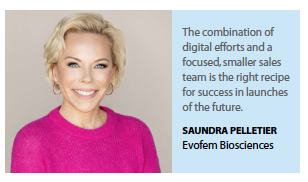 A second fearless company, Evofem Biosciences, did not hesitate to pivot its launch of Phexxi, a new hormone-free birth control gel, when it was approved in May 2020, smack in the middle of COVID. Instead of postponing or cancelling the planned launch, the company did a 180-turn in its strategy. It’s all about being nimble, CEO Saundra Pelletier says, and being prepared to pivot and then pivot again.
A second fearless company, Evofem Biosciences, did not hesitate to pivot its launch of Phexxi, a new hormone-free birth control gel, when it was approved in May 2020, smack in the middle of COVID. Instead of postponing or cancelling the planned launch, the company did a 180-turn in its strategy. It’s all about being nimble, CEO Saundra Pelletier says, and being prepared to pivot and then pivot again.
“This launch required the ability to be nimble on frontline operations and make the right pivots, sometimes on a weekly basis," Ms. Pelletier says. “Small companies like ours have the competitive advantage on that by a big margin."
The plan to continue with the launch during COVID was met with skepticism from others, but the company reasoned that the unmet need for non-hormonal birth control for women still very much existed during the pandemic.
The original launch plan for Phexxi relied heavily on a large sales organization reaching out directly to physicians, with little thought given to using telemedicine. However, after some extensive market research with women and physicians, Evofem decided to try a digital plan and launched in September. Prevented from deploying a large sales team, Phexxi used TV, Instagram, Facebook, Pandora, and the voice of social media influencers. Evofem also launched a telemedicine support system, the Phexxi Concierge Experience, for patients and healthcare providers.
The results of the new digital strategy have been remarkable, Ms. Pelletier says. “We have seen a 362% increase in direct searches for Phexxi just since our TV commercial aired on Valentine’s Day; more than 173 million views across online and television; and 1,258% increase in telehealth search since the commercial," she says.
And the tally continues: More than 2,400 Phexxi units were dispensed in February 2021, up 30% from the month before; accelerating retail demand drove a 73% increase in ex-factory sales month-over-month; and ex-factory sales year-to-date 2021 through mid-March have exceeded FY 2020 levels.
The combination of the digital efforts and a focused, smaller sales team was the right recipe for success, not only for Phexxi, but for all products being launched in the future, Ms. Pelletier says.
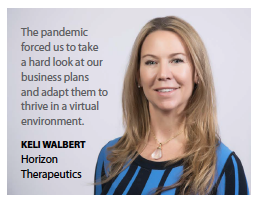 “We have 59 sales representatives and 11 managers, and they have done fantastic through all this," she says. “But our telemedicine investment was much more significant than we would have done if it we weren’t in COVID."
“We have 59 sales representatives and 11 managers, and they have done fantastic through all this," she says. “But our telemedicine investment was much more significant than we would have done if it we weren’t in COVID."
According to Mary Corcoran, group president, integration and operations, at Real Chemistry who works with Alisa Lask, VP and general manager, U.S. aesthetics, at Galderma, the pandemic only accelerated the industry to where it was already heading.
“One of the many key insights from 2020 is the importance of value over volume," Ms. Corcoran says. “2021 campaigns will incorporate critical learnings from the past year and build on them to ensure programming delivers more value than ever before to healthcare companies and the HCPs and patients they serve."
“Last year when the COVID-19 pandemic hit, the aesthetics industry had to quickly pivot and adapt to how we reach consumers," Ms. Lask says. “For Galderma, this meant rethinking our launch strategy for our new dermal filler Restylane Kysse in the context of a new normal."
Ms. Lask says the launch team took a digital-first approach to the Restylane Kysse launch, given consumers were more frequently on their phones or in front of their computers and were increasingly turning to social media to keep up with the latest trends and newest products and to seek expert opinion.
Knowing that consumers want to hear first-hand experience from someone they trust, Galderma turned to content creators to share their experience with Restylane Kysse with their own followers. “This ultimately drove people back into injector’s offices when practices were able to reopen, and the launch of Restylane Kysse was our company’s most successful to date," Ms. Lask says.
“Seeing how positively consumers respond to influencers who share their real experiences using Restylane Kysse, we are expanding our work with these influencers in 2021 to encompass more Galderma brands and products."
In January 2020, Horizon Therapeutics received the good news that the FDA approved its drug Tepezza as the first and only medicine to treat thyroid eye disease (TED). Little did they know the country would face a nationwide shutdown just six weeks later because of COVID-19. Horizon was able to launch immediately after approval, which helped the team get a head start in terms of starting patients on therapy. But as doctor’s offices closed and social distancing measures began, they had to quickly adapt their approach.
“A product launch is, in many ways, a company’s first impression with doctors and patients," says Keli Walbert, executive VP, infused medicines and strategic marketing, Horizon Therapeutics. “As a result, nimble frontline operations have been a continuously important factor for us while launching Tepezza, especially because most of our launch has taken place during a pandemic. We have had to be flexible and quick on our feet to adapt to the changing needs of doctors and patients."
For example, ahead of FDA approval, the company had invested in a dedicated salesforce whose goal was to educate doctors about TED. This salesforce combined a traditional physician sales team with a sales team specifically targeted to IV infusion centers to help ensure ease of referral to their facilities for appropriate patients. Once the COVID-19 outbreak hit the 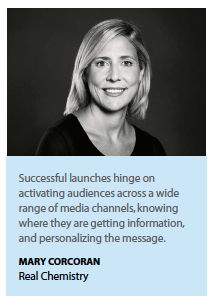 United States, the salesforce could no longer meet with doctors in their offices, so Horizon created tools to facilitate those virtual conversations. “The work we did before FDA approval was critical, because many times those virtual conversations were not our first introductions — a relationship had already been established," Ms. Walbert says. “Another important step we took was to establish a team of people whose primary role was to interact with the sites of care, such as infusion centers. Before launch, we assessed all of our customers — weighting them as equally important — and identified sites of care as a gap. Infusion medicines have a different, more expansive customer group than traditional therapies and we saw a need to support all of our customers across multiple customer journeys. In fact, when our team went out with materials designed just for our site of care customers, many said it was the first time anyone had called on them with dedicated support and content."
United States, the salesforce could no longer meet with doctors in their offices, so Horizon created tools to facilitate those virtual conversations. “The work we did before FDA approval was critical, because many times those virtual conversations were not our first introductions — a relationship had already been established," Ms. Walbert says. “Another important step we took was to establish a team of people whose primary role was to interact with the sites of care, such as infusion centers. Before launch, we assessed all of our customers — weighting them as equally important — and identified sites of care as a gap. Infusion medicines have a different, more expansive customer group than traditional therapies and we saw a need to support all of our customers across multiple customer journeys. In fact, when our team went out with materials designed just for our site of care customers, many said it was the first time anyone had called on them with dedicated support and content."
Lessons Learned
No one could have anticipated the global pandemic or the impact it would have on the world. Many decisions had to be made quickly and often for the first time across all industries. The pharma industry in particular had to play catch up in terms of technology and digitalization and definitely move outside its comfort zone.
“The COVID pandemic certainly enforced changes that drove the industry to adapt and pivot quickly," says John Tenaglia, managing partner at Moon Rabbit.
Mr. Tenaglia says it is as important for pharma to focus inhouse when responding to the changes COVID has brought to the environment as it is to look outward to consumers.
“Equally as important as getting our customers excited, is keeping our internal teams excited during this hard time," he says. “These teams need to be kept engaged, and need to believe in what we are doing and the power of the brand and the change it will bring."
While working on launches during COVID, his team developed teaser videos, launch videos, and post-launch motivational videos for internal teams: sales, marketing, medical, and operations. Sometimes in post-launch content, they would be sharing testimonials from KOLs letting sales reps know the positive impact they and the product have. The effort to keep the teams spirits high was paramount, in this time of change and uncertainty for internal stakeholders.
Dr. Deignan of BMS also mentioned the importance of taking care of and checking in with employees during the upheaval.
“I spent a lot of time in the early stages of the pandemic connecting with employees to make sure they were okay as people," she says. “Our people have personal lives with their own priorities they have to look after. One of my areas of focus was making sure they felt supported by the company as they were trying to navigate the craziness that they were now stepping into with kids at home, with managing risks with elderly parents, and all of the various personal challenges they were managing through. Making them feel safe, secure and supported was absolutely critical because they were then able to make the flex to say ‘okay, how are we going to get the job done in this different environment.’ "
The adaptation to virtual broadcasts came with a lot of learnings around optimizing the customer experience, Mr. Tenaglia says. To effectively reach HCPs the industry needed to not just leverage the big platforms but change 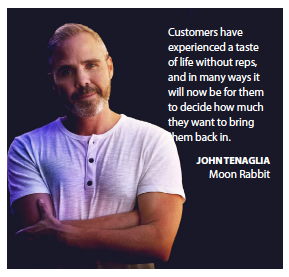 what companies were doing on them. “We’ve seen an increased appreciation of branding through the COVID period as so much of the brand experience is unaided," he says.
what companies were doing on them. “We’ve seen an increased appreciation of branding through the COVID period as so much of the brand experience is unaided," he says.
“When we pivoted to a virtual launch due to COVID, we learned three very specific lessons," Ms. Pelletier says. “The first lesson is that it is critical to reach out to the end user, the target audience, and the demographic audience in a precise and focused and edgy way, to get their attention. We learned that we needed to know what were the specific levers that we had to push for women."
Besides learning the importance of precise messaging to the consumer, Ms. Pelletier says the second lesson learned was that they would get better results by segmenting the physician market on attitudinal behavior and not on prescribing habits. “We wanted to target prescribers who care about really talking to their patients," she says.
The telemedicine component of the launch presented a third opportunity for learning that also paid off.
In the month of February, more than 800 women leveraged the Phexxi concierge telehealth platform. Ms. Pelletier credits the success of the platform with the fact that due to COVID a lot of women were home at that time.
“Telemedicine has helped us continue to drive demand during COVID," she says.
Ms. Lask says likewise it was the limited opportunity for in-person interactions that drove digital application and virtual education during COVID. “Virtual technologies have allowed us to continue to engage with patients and providers in meaningful ways, despite the current global health crisis," she says. “Last year, we turned all of our Galderma Aesthetic Injectors Network trainings into virtual webinars allowing us to offer trainings to twice the number of HCPs from the year prior."
As people increasingly adopt technology to understand, manage, and improve their health, social media has become an integral part of how medical information is shared between healthcare professionals and consumers and is an essential part of the health data ecosystem. Ms. Corcoran adds, “I would go so far as to say establishing relationships with physicians and patients can actually be easier in our virtual environment."
According to recent research from Real Chemistry, sharing medical information by doctors increased by 26% year over year, resulting in greater access for consumers to scientific information. The research suggests an emerging tide of physicians who are connecting patients directly with medical literature, often in a way that explains or contextualizes that literature, which has important implications for the future of healthcare.
“The COVID-19 pandemic has changed the way we do nearly everything, and we know from experience how important it is for a company to be nimble when faced with any new challenge," Ms. Lask says. “We focused our efforts 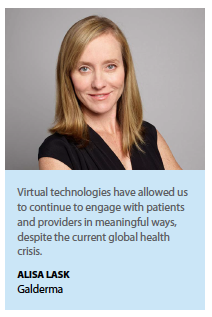 on ensuring providers and their patients felt supported during these difficult times. As part of this commitment, we made several modifications to offer greater flexibility and support."
on ensuring providers and their patients felt supported during these difficult times. As part of this commitment, we made several modifications to offer greater flexibility and support."
Some of that support included transitioning all professional trainings and salesforces to a virtual setting; launching consumer digital promotions for patients to earn more ASPIRE points to help spur patient demand once practices reopen; and working with providers on following necessary safety protocols as they begin to reopen.
Future Launches Post-Covid
According to McKinsey, it is too soon to evaluate the full impact of the COVID-19 pandemic on drug launches. However, it is clear there will be major shifts in the way that HCPs interact with pharma companies going forward. One consequence of the pandemic has been a drastic reduction in pharma companies’ visits to HCPs. A survey conducted by McKinsey in Europe shows that the average number of in-person contacts between HCPs and pharma sales reps was 70% lower in September 2020 than before the pandemic. In parallel, HCPs’ adoption of digital channels and telemedicine has accelerated for interactions with patients and pharma reps alike. In the same survey, the HCPs who are highly open to remote engagement with sales reps report conducting almost half of their patient consultations remotely as well.
Our experts predict that launches post- COVID will most likely be a hybrid model of some face-to-face interaction when it’s safe and the use of virtual tools. The industry was headed in this direction, but it was projected it would take at least five more years to get there. COVID just accelerated the hybrid model.
Ms. Walbert says the industry’s promotional environment is forever changed. “The pandemic forced us to take a hard look at our business plans and adapt them to thrive in a virtual environment," she says. “Through this process, we’ve learned a lot about how our stakeholders like to consume information and what approaches are most effective. Although in-person office visits and medical congresses will resume as the world opens again, digital isn’t going anywhere. It will remain a central part of our efforts to reach stakeholders in meaningful ways."
“I do believe future launches will be a hybrid model," Dr. Deignan says. “I think the role of our customer-facing teams, be they commercial, medical, or access, will remain critical to the success of launches. Because at the end of the day, relationships are essential with our healthcare practitioners. Our efforts in the future will be more tailored for the different customer segments than we’ve done in the past."
Ms. Corcoran from Real Chemistry says thinking “digital-first" is just the first step in a post-pandemic approach to launching products and therapeutics.
Strategies must be informed by data and designed to create holistic, highly relevant digital experiences for patients and HCPs. “Our audiences expect more from us than ever," she says. “Successful launches hinge on activating audiences across a wide range of media channels, and not only knowing where they are getting information, but personalizing the message to their specific interests and lifestyle."
“The past year has made an online presence even more important as our phones and computers became our windows into the rest of the world," Ms. Lask adds. “I expect this will continue as more providers take their practice online and even on social media, which we know is a primary place to connect with both new and existing aesthetics patients."
For Ms. Pelletier, a greater reliance on social media influencers is the way of the future with fewer sales reps.
“Social media influencers have value, and when people follow these influencers, they want to mimic their behavior; they trust their guidance," she says. “We’re going to continue to lean into the social media influencers who have not only intuitively understood our mission, but have embraced it."
Dr. Deignan sees the future as being very bright for this new model, which has been shaped so quickly from COVID. “I’m excited to see where we’ll be able to take this, and I am excited to come out of this acute period of the pandemic into a new hybrid model, and I am excited because I think we can do more for patients," she says. “Looking forward a few months, I’m optimistic about where we will be in our recovery and am looking forward to being able to implement a blend of both in-person interactions and remote engagement to best meet the needs of our different customers, and ultimately, deliver the best outcome for patients in need."
“Undoubtedly, there will always be digital components to future launches, as indeed there had been pre-COVID," Mr. Tenaglia says. “The question of course is really what the balance looks like. Customers have experienced a taste of life without sales reps, in many ways it will now be for them to decide how much they want to bring them back in. And equally, up to brand managers to decide how to balance the interaction with their customers."(PV)
~~~~~~~~~~~~~~~~~~~~~~~~~
Five Linked Imperatives Can Create the Conditions for a Successful Launch
Rapidly Personalized Content: Create cutomer-centric content via rapid iterations, tailoring information to each indvidual’s interests.
Analytics-Enabled Engagement. Facilitate personalized enagement via tools that support reps’ decision making, integrate user feedback, enable the optimation of channels and content mix, and foster continuous learning.
Innovative Patient Channels and Services: Develop channels and services for patients that facilitate diagnosis, treatment choice, and administration in remote settings.
Nimble Frontline Operations: Reimagine the front line and equip reps with remote selling capabilities, digital-channel expertise, analytic insights, and learning tools.
Closed-Loop Execution: Implement closed-loop execution with rapid iterations linking local execution with launch plans to generate insights and support rapid responses to changes in circumstances.
~~~~~~~~~~~~~~~~~~~~~~~~~
Key Lessons Learned During a COVID Launch: Tepezza
The FDA approved Tepezza as the first and only medicine to treat thyroid eye disease (TED) in January 2020. Then COVID hit. These are the lessons Keli Walbert, executive VP, infused medicines and strategic marketing, at Horizon Therapeutics, says she and her teams learned during the experience:
Communication is key: Our patient services team includes patient access liaisons, or PALs, who provide dedicated support to Tepezza patients during their treatment journey, such as providing guidance to help navigate insurance challenges and identifying infusion center options. When the pandemic began, the role of the PALs became even more critical. They maintained open lines of communication with patients and were able to troubleshoot pandemic-related challenges, such as infusion centers closing or patients wanting to explore home infusion as an option because they were scared to leave their homes to get their treatments. Having direct contact with patients in this way helped us to better understand their concerns and address their needs.
Digital is here to stay: Although we’ve known for a while that digital plays a crucial role in reaching patients and customers, the pandemic made the benefits of digital even more evident. For instance, when doctors’ offices closed, we were able to maintain contact with prescribers through tools that supported our field sales team with virtual engagements.
Although there is still value in having face-to-face interactions with doctors and other customers, we have been able to effectively maintain these relationships virtually. I think to some extent, we’ll see a continuation of these remote interactions, even after the pandemic ends.
Be flexible: Before the pandemic, we had planned on launching a series of video ads about TED that would appear in various online channels. But when TV consumption skyrocketed as a result of stay-at-home orders, we saw an opportunity to quickly pivot and expand our efforts to include a DTC TV campaign. After a pilot in a handful of local markets went exceedingly well, we expanded to a national media buy. This was Horizon’s first TV commercial and although it wasn’t something we’d initially planned for this specific ad, having an open mind and being willing to try something new has paid off.
Have a fail-fast mentality: Over the past year, because of the pandemic, the overall environment has been very volatile. What was once the case a month ago, no longer is today, and so on. Our customers’ needs are continuously changing, and we have had to be nimble in our approach so we can adapt when needed. We have made the conscious decision to take risks and have a fail-fast mentality. This means we are willing to test new ideas, but quickly change course if the approach isn’t working.
Relationships matter: We greatly value the relationships we have with doctors on the frontlines and work closely with them to find out what they need for their patients. Those existing relationships with doctors helped us continue the successful launch of Tepezza, despite the pandemic complexities.


















